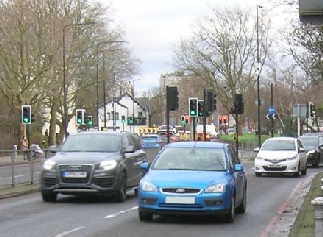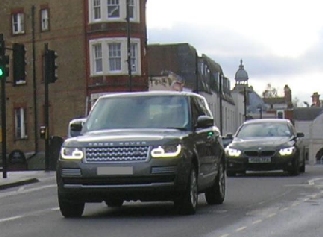455
Concerns
with the relative visibility of classic cars
Classic car enthusiasts are increasingly aware that with the
growth of bright Daytime Running Lights (DRLs) on modern
cars which have become much larger, not least from the growth
in new SUVs and 4x4s, the relative visibility of a car like
an MGBGTV8 is becoming a real concern. They are also aware that
when you drive on UK roads today you sense that MGV8 is much
smaller than many modern cars which seem to get larger and larger
- not to mention the explosion of even larger SUVs and 4x4s.
With the combination of these factors a classic car driver naturally
feels concerned their car from the 1970s is less noticeable
on a relative visibility basis and consequently is aware
it can be less easy to see a classic car on the road or in a
rear view mirror.
Here we set out concerns with the relative visibility
of classic cars today highlighting a number of the factors contributing
to reduced relative visibility and the available DRL options
for an MGV8.
Here
See a copy of the full article covered by this webpage.
V8NOTE574
200220
|

Few cars on the roads
today don't have DRLs and SUVs and 4x4s are much larger
What are the concerns?
When you drive an MGB or derivative like the MGBGTV8 on UK roads
today you sense that it is much smaller than many modern cars
which seem to get larger and larger - not to mention the explosion
of even larger SUVs and 4x4s. Modern cars also have bright daytime
running lights as
standard equipment, so a classic car driver naturally feels
concerned their car from the 1970s is less noticeable on
a relative visibility basis and consequently is aware it
can be less easy for other drivers to see a classic car on the
road or in their rear view mirror.
Classic cars today are relatively smaller when compared with
modern cars
To see just how much bigger a typical modern car is today we
have looked at a VW Golf, the longstanding popular hatchback
that has been around since 1974, and compared it with the most
recent Golf 2020 model. Then we have compatred the 2020 Golf
with an MGBGTV8 which was launched in 1973. The relative size
factor has been analysed using the comparative volume and
frontal area of each car.
What can we see?
Well a VW Golf 2020 is now 35% larger (frontal area) and
47% larger (volume) than an MGBGTV8. Since 1974 the new
VW Golf model 2020 is now 15% larger (frontal area) and 33%
larger (volume) than a VW Golf in 1974. See our report on this
Golf 1973-Golf 2020-MGBGTV8 comparative size analysis. Report
Major increase in the use of daytime running lighting on
more modern cars and other vehicles
A classic car without similar bright daytime lighting, increasingly
a standard feature with modern cars, inevitably tends to appear
less visible to other drivers, so a prudent choice for a
classic car driver is to use dipped daytime headlights.
Some enthusiasts have gone further with modifications which
retrofit Daytime Running Lights (DRLs). Our article on the daytime
lighting choices for a classic car owner looks at several options.
DRLs options for classic cars
Older lighting/bulb
technology tends to be used on classic cars
With original sealed beam units or headlamp upgrades with incandescent
bulbs, the brightness of the headlights on a classic car can
be much lower than that of most other modern vehicles on the
road. Some classic car owners have upgraded their headlights
with brighter Halogen bulbs or even HIDs and have also used
brighter rear stop/tail lights with LED bulbs with the aim of
trying to ensure their car is more visible on the road.
Lighting upgrades for classic cars
Traffic
volumes on our roads have increased in a major way over the
last 10 to 20 years
The increased traffic has usually resulted in more |

Large 4x4s and SUVs
are higher and larger with bright DRLs in a variety of stylish
arrangements
concentrated flows
of vehicles on major roads and motorways and often consequently
less forward visibility of vehicle movements ahead to enable
a driver to anticipate safety issues. In poor road conditions
like rain with spray or in mist those risks increase substantially.
Noticeable changes
in driving behaviours and styles have developed over the last
10 to 15 years
Typically we see much closer nose to tail driving habits becoming
the norm. Whether this is because drivers feel modern cars are
safer with antilocking brakes is not clear but closer driving
is certainly seen generally, particularly when traffic volumes
are moderate to high. The effect on motorways, when a driver
who is close to another car ahead senses a problem and brakes
so their rear stop lights come on, is you often see that stop
lights reflex is then repeated in a pulse-like manner back down
the line of nose to tail cars behind.
The effect is to disrupt the smooth flow of traffic and raise
the tension in driving, but it also
tends to reduce the average cruising speed of the general mass
of drivers with some drivers showing signs of frustration with
the "blockage" ahead. Clearly driving close behind
other cars increases the need for other cars around you to be
visible - and seeing them becomes a vital safety issue.
Nostalgia for driving in earlier times
So whilst one might nostalgically recall the halcyon days when
drivers in cars not then fitted with antilocking braking travelled
at sensible speeds on roads and motorways in lighter traffic
conditions with prudent nose to tail spacing, traffic volumes
were then a very great deal lower than today. The reality is
times have changed.
Similarly with vehicle lighting, the use of dipped headlights
rather than simply sidelights in built up areas with street
lighting has become the social norm today and regarded by many
as a safer way of ensuring visibility of their car. In poor
road conditions with rain and spray it is astonishing how often
you see cars with no dipped headlights on. Where they have DRLs
on in those conditions it is not clear whether some drivers
are aware the back of their car needs to be seen by fellow drivers
because with DRLs switched on most installations do not also
have the rear lights on. Maybe some users of DRLs in poor conditions
feel their DRLs provide good frontal visibility but they believe
they do have rear lighting with DRLs and that is why they do
not switch on their dipped headlights instinctively.
So relative
visibility is an important matter for both daytime driving and
driving in poor road spray and mist conditions - and the
more so for classic cars for the reasons set out above.
See
a full copy of this article |




